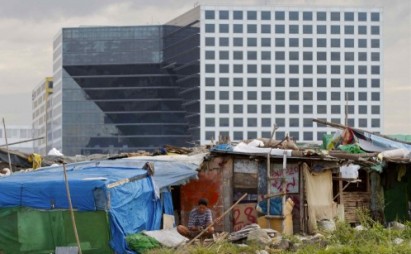(Editor’s note: Cesar Polvorosa Jr. is an InterAksyon.com reader from Toronto. This piece is an abridged and updated version of one that originally came out in The Manila Review last February 1. He gave InterAksyon.com permission to post this. An economics research and corporate planning officer in Philippine financial institutions in both private and public sectors in the past, he is now a business school professor of economics, world geography, and international business in Canada. He is also a published writer in economics, business, and literary fields.)
The rise of a country fascinates historians, investors, economists, and researchers. The Philippines, widely heralded as the next tiger economy of Asia, has been in the spotlight for its recent stellar economic performance. The country’s robust economic growth of 7.2% in 2013 maintained its enviable status as one of the fastest growing Asian economies.
There is a need, however, to temper exuberant expectations as the rapid growth has only been recent. Economic powerhouses China, Japan, and South Korea advanced from decades of blistering 8-10% annual growth. In stark contrast, the Philippines expanded at a lacklustre average of 3.3% from 1980 to 2012.
It is déjà vu as well: the economy has been on this path before and they proved to be false dawns. The Philippines was once a progressive Asian country second only to Japan. It was acclaimed as a rising Newly Industrializing Country (NIC) in the 1970s and again in the mid 1990s.
Why is the country unable to achieve higher sustainable growth? For post-war Philippines, domestic upheavals were governance crises that derailed the economy. “Governance,” notes the IMF, includes “all aspects of the way a country is governed, including its economic policies and regulatory framework, as well as adherence to the rule of law.” The failure of Philippine governance has triggered periodic upheavals with grave economic repercussions.
Boom and bust cycles: Crises of governance
The 1980s marked a major crisis of governance for the Philippines that culminated in the People Power revolt of 1986. Average economic growth plunged to -1% during 1983–1987.
The Ramos presidency restored stability and boosted average growth to 5% in a rare period of relatively good governance for the Philippines. The country was again hailed as an emerging NIC but that vision vanished with the 1997 Asian Financial Crisis, the turbulent Estrada term, and the 2001 People Power 2 protests. The Arroyo government improved average growth to 5.7% during 2003-2007, though corruption scandals hounded the latter part of her term. In short, the Philippine economy failed to sustain respectable growth during the past generation.
There were periods of uncertainty and two regime changes initiated by the Parliament of the Streets. During the past 13 years, the country has ousted and prosecuted one president, while investigating another. A Supreme Court chief justice has been impeached and ousted as well. Clearly, the Philippine ship of state, often with an inept helmsman and crew members that plundered from the passengers, was a decrepit vessel.
Excising predatory regimes will have short-term economic disruptions but eventually good governance will enable the country to fulfill its development potential. Without the real cure, however, the crisis of governance will recur. What is the origin of this disease?
History matters: Philippine political economy
Philippine underdevelopment can be explained by path dependency: examining the role of history in the paths that nations take. Centuries of colonization have created a narrow elite dominated society while the vast majority have been mired in poverty and servitude.
The Spanish colonizers instituted the encomienda system—a feudal system patterned after the governance template of their Latin American colonies. Power and extractive political and economic institutions benefit a small elite which leads to weak institutions, fragile governance structures, and constrained social mobility. Political dynasties strive to cling to power. Corruption becomes embedded and institutionalized in relations and transactions.
The colonial rule of the United States ostensibly established democracy in the Philippines but it gave an immense advantage to the entrenched economic and political elite, the oligarchy, while weakening the peasantry and the middle class. Consequently, the Philippines have one of the highest income disparities in the region. High inequality aggravates poverty levels, fuel widespread resentment, and sociopolitical instability.
Corruption and underdevelopment: State capture and regulatory capture
According to the IMF, “Corruption is a narrower concept than governance. It is often defined as the abuse of public authority or trust for private benefit. The two concepts are closely linked. Where there is poor governance, there are greater incentives and there is more scope for corruption. There is also a reverse link: Corruption undermines governance to the extent that it distorts policy decisions and their implementation.”
The most pernicious form of corruption is the pervasive and systemic abuse in the allocation of public resources. Firms, bureaucrats, and elected officials influence the rules of the game through decrees and regulations on the allocation of resources. The system is particularly insidious because of its veneer of legality, as is evidenced in the pork barrel system.
Given the historical context, can the pork barrel scandal be just the tip of the iceberg? Corrupt practices, e.g. the bribery of officials for the creation of ghost projects, have profound inimical effects as they starve priority sectors such as education, healthcare, and infrastructure. Imported luxury goods acquired by corrupt politicians do not create local jobs. Investors bring jobs and technologies to other countries while local entrepreneurs are hobbled by red tape, bribery, lack of financing, and deplorable infrastructure. Thus, while the destructive power of Yolanda/Haiyan was unprecedented, systemic corruption resulted in inadequate infrastructure to prepare for the typhoon and the relief operations. The perception of corruption made many Filipinos and foreigners hesitate to give donation money and relief goods.
The lost luster of public office stained by corruption attracts individuals with dubious qualifications and unscrupulous morals who gain a sense of entitlement and impunity. The impoverished masses become vulnerable to vote-buying. Subsequently, the lack of domestic jobs forces many to work abroad, leading to brain drain and the break-up of families.
Can cross country data show connections between corruption levels and the state of national development? Analyzing data from Transparency International for corruption, World Bank and the United Nations for income and human development indicate that countries with the least level of corruption, e.g. Denmark, New Zealand, Finland, Singapore, Australia, Canada, and United States, achieved the highest average incomes and quality of life and those countries that are seen as more corrupt, e.g Philippines, India, Bolivia, have lower average incomes and quality of life.
For 2013, the Global Corruption Index for the Philippines showed that majority of respondents perceive that key Philippine institutions were corrupt/extremely corrupt: political parties (58%), police (69%), public officials and civil servants (64%), and legislature (52%).
Sustaining economic growth and development: Beyond the pork barrel scandal
The Philippine economy is forecasted to grow 6.5%=7.5% until 2016, the end of President Aquino’s term. The general absence of prognosticating beyond 2016 manifests the perceived risks with each new administration and the continuing immaturity of democracy in the country.
As Acemoglou and Robinson explain in their book Why Nations Fail, countries with extractive political and economic institutions may grow but it will be unsustainable. Misallocated resources from corruption make it harder to achieve and sustain growth. Philippine economic growth has disproportionately benefited the country’s elite. Poverty is persistently high at about 28% of the population and unemployment remains above 7%. The highly unequal income distribution in the Philippines is disturbing as equality is important in promoting and sustaining growth. Widening inequality deepens the fault lines in society that can eventually lead to sociopolitical upheaval.
Historically, People Powers 1986 and 2000 may represent only the initial crucial steps of Filipinos to establish genuine democracy and good governance in the country. People Power did not change the rules of the game and the oligarchy remained firmly in place—and governance crises keep recurring. The Million People March to protest against the pork barrel may represent real progress—only if the people build upon the historic momentum.
The good governance imperative requires the prosecutions of erring officials but demands in the long run, the overhaul of entire systems and institutions. The Philippines needs to undertake systemic reforms by integrating firm anti-corruption mechanisms in its governance structures necessary to unleash the full creative and productive energies of Filipinos.
Good governance requires political will and commitment to the shared prosperity of Filipinos regardless of class. The political leadership needs to transcend its elite class interests to engender sustainable and inclusive economic growth. Good governance can be the enduring legacy of the present administration if it acts with decisiveness, persistence, and clarity of vision.










